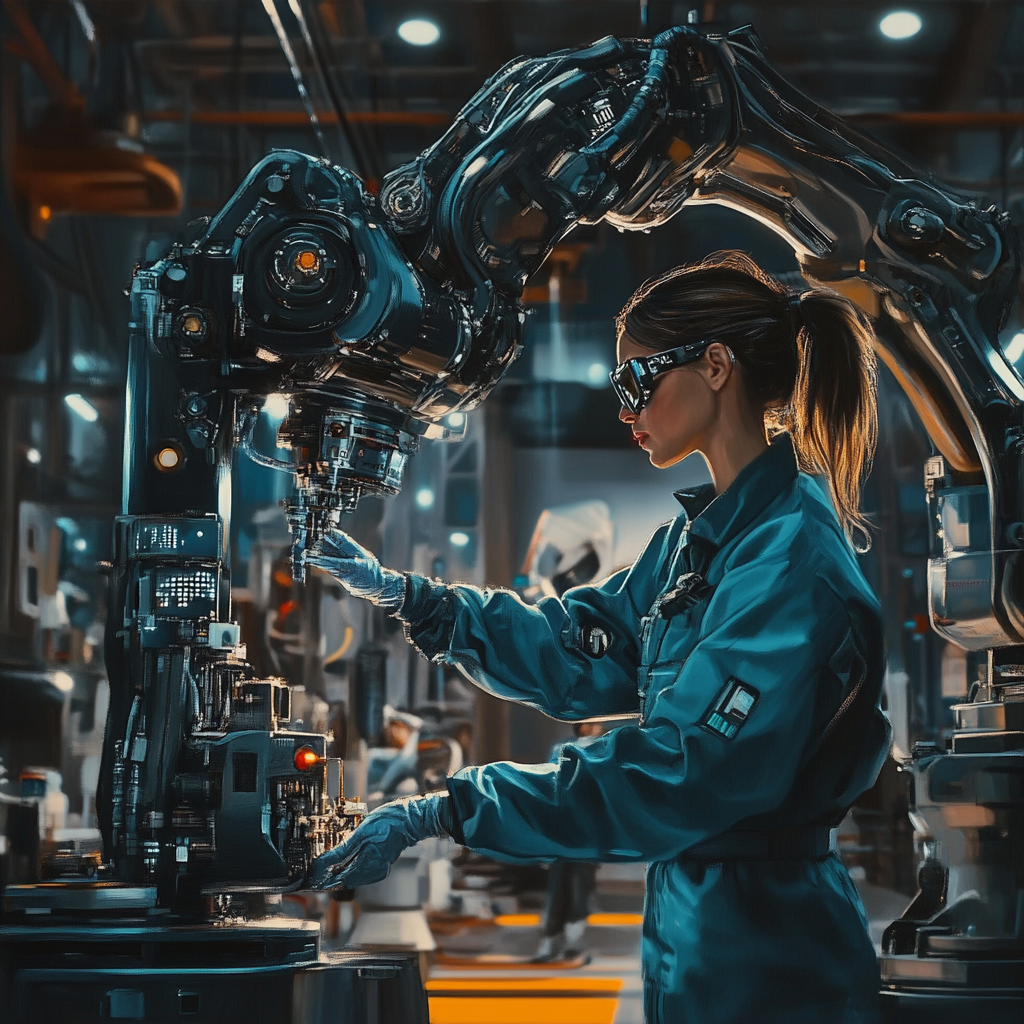One of the papers I wrote for Strategic Management in my graduate studies is about Industry 4.0. Before that course, I only read about Industry 4.0 in ads by MIT on their course “Professional Certificate in Industry 4.0” (MIT). My teammates and I spent a lot of time researching, discussing, and writing about this industry. So here is my quick info guide on this industry.
What is Industry 4.0 in Simple Definition?
Industry 4.0 is simply the fourth industrial revolution and was born in 2011; it is a fundamental advancement in how we produce and consume goods and services. Industry 4.0 is characterized by new technologies and capabilities transforming factories, supply chains, and entire industries.
Industry 4.0 has the potential to change the manufacturing industry.
Industry 4.0 is technologically driven and involves the following key features:
Smart factories are factories where machines and equipment are connected through the Internet of Things (IoT) and communicate with each other, enabling real-time monitoring and control.
The Smart factory is a highly automated and connected industrial facility, with machines and equipment communicating with each other and central control systems. This connectivity is made possible through the Internet of Things (IoT), which refers to the network of physical objects (such as machines, sensors, and other devices) that are embedded with electronics, software, and network connectivity, enabling them to exchange data and communicate with each other.
In a smart factory, machines and equipment are equipped with sensors and other IoT-enabled devices to collect and transmit data about their performance, status, and additional relevant information. This data is then analyzed by central control systems and other software applications, which use advanced algorithms and machine learning to monitor, optimize, and control the factory’s operations in real time.
The benefits of a smart factory include the following:
-
- Improved efficiency: By collecting and analyzing data in real-time, smart factories can identify and eliminate inefficiencies in the manufacturing process, resulting in increased productivity and reduced waste.
- Increased flexibility: Smart factories are designed to be highly flexible and adaptable to changing production requirements or customer demands quickly and easily.
- Enhanced quality control: The real-time monitoring and control of smart factories’ production processes can help detect and correct quality issues quickly, resulting in higher product quality.
- Reduced downtime: Smart factories can identify and address maintenance issues before they cause downtime or equipment failure, resulting in more reliable and predictable operations.
Several studies and reports estimate the potential financial benefits of implementing smart factory technologies. Here are some examples:
-
- A report from Capgemini estimates that smart factories can lead to a 10-20% improvement in productivity, a 15-25% reduction in maintenance costs, and a 20-30% reduction in quality defects. Based on these estimates, the report suggests that a typical smart factory can generate $500 million in cost savings and revenue growth over five years.
- A study from Deloitte estimates that Industry 4.0 technologies, such as smart factories, can lead to a 14.9% reduction in manufacturing costs and a 15.1% improvement in manufacturing capacity. The study suggests that these improvements can lead to a 3.6% increase in revenue and a 2.0% increase in net profit.
- A study from McKinsey & Company estimates that Industry 4.0 technologies, such as smart factories, can lead to a 20-30% improvement in equipment effectiveness, a 10-20% reduction in maintenance costs, and a 10-20% reduction in quality defects. The study suggests that these improvements can lead to a 10-20% improvement in overall equipment effectiveness and a 3-5% improvement in gross margin.
While these estimates are based on assumptions and may not apply to every business, they suggest that the financial benefits of implementing smart factory technologies can be significant. Businesses can generate cost savings, revenue growth, and increased profitability by improving efficiency, reducing waste, and improving quality.
Overall, smart factories are a vital component of Industry 4.0, representing the next stage of development in manufacturing and other industrial sectors. By leveraging the power of IoT, advanced analytics, and other technologies, smart factories can achieve greater efficiency, flexibility, and productivity than traditional manufacturing facilities.
Data-driven decision-making: Advanced analytics and machine learning algorithms enable companies to collect and analyze vast amounts of data from different sources to make better decisions.
Data-driven decision-making is an approach to making decisions that involve using data, analytics, and other quantitative methods to inform and support the decision-making process. In Industry 4.0, data-driven decision-making is made possible by the abundance of data generated by IoT sensors, production processes, and other sources.
The basic idea behind data-driven decision-making is to use data to gain insights and knowledge that can help to guide decision-making. By collecting and analyzing data, decision-makers can identify patterns, correlations, and other trends that might take time to be apparent from other sources. This can improve the accuracy and effectiveness of decisions and lead to better business outcomes.
Here are some of the critical steps involved in data-driven decision-making:
-
- Identify the problem and help with the decision: The initial step is to clearly define the problem or decision that needs to be made. This could be anything from a production issue to a marketing decision.
- Gather relevant data: Once the problem has been identified, the next step is to gather relevant data, which involves collecting data from IoT sensors, analyzing historical production data, or conducting surveys of customers or employees.
- Analyze the data: With the data collected, the next step is to analyze it to gain insights and identify trends. This might involve using statistical analysis tools, machine learning algorithms, or other analytical methods.
- Make the decision: Once the data has been analyzed, it can inform decision-making. Decision-makers can use the insights gained from the data to make more informed and data-driven decisions.
Data-driven decision-making can offer several benefits for businesses.
-
- Improved accuracy: Data-driven decision-making helps to eliminate guesswork and intuition from the decision-making process, resulting in more accurate and precise decisions.
- Increased efficiency: By identifying patterns and trends in data, decision-makers can optimize processes and reduce waste, resulting in greater efficiency.
- Better insights: Data-driven decision-making enables decision-makers to gain insights into complex problems that might not be immediately apparent from other sources.
- Improved customer satisfaction: Businesses can identify trends and preferences by analyzing customer data, allowing them to tailor their products or services to meet customer needs better.
- Reduced risk: By analyzing data and identifying potential risks, decision-makers can take proactive steps to mitigate them before they become problems.
- Greater agility: Data-driven decision-making allows businesses to respond swiftly to volatile market conditions, customer needs, and other factors that might impact their operations.
- Improved innovation: By using data to identify new trends and opportunities, businesses can drive innovation and find new ways to improve their products, services, and operations.
- Improved profitability: By reducing waste, increasing efficiency, and improving quality, data-driven decision-making can lead to greater business profitability.
Several studies and reports that attempt to estimate the potential financial benefits of implementing data-driven decision-making. Here are some examples:
-
- A study from the Harvard Business Review learned that companies that use data and analytics to make decisions are more productive and profitable than their competitors. The study found that these companies have a 5-6% higher productivity and profitability than their competitors.
- A report from McKinsey & Company found that businesses that use data and analytics to inform their decision-making are 23 times more likely to acquire customers and six times more likely to retain their customers. They are also 19 times more likely to be profitable than competitors that do not use data-driven decision-making.
- A report from Forrester Research found that businesses that use data and analytics to inform their decision-making can increase their revenue by up to 5%, reduce costs by up to 6%, and increase profitability by up to 8%.
While these estimates are based on assumptions and may not apply to every business, they suggest that the financial benefits of implementing data-driven decision-making can be significant. Businesses can generate cost savings, revenue growth, and increased profitability by improving accuracy, efficiency, and profitability.
Overall, data-driven decision-making is a powerful tool that can help businesses to make more accurate, efficient, and profitable decisions. By leveraging data and analytics, companies can gain insights that might not be available from other sources and make decisions that are more closely aligned with their strategic goals and objectives.
Customization: The use of digital technologies allows for more flexible production processes, enabling companies to respond quickly to changing customer demands and produce customized products at scale.
Customization is one of the key benefits of Industry 4.0 and refers to the ability of businesses to produce customized products at scale. This is made possible by integrating digital technologies, from design to production and delivery, across the entire manufacturing process.
Mass production was the dominant manufacturing model in the past, with businesses producing large quantities of standardized products. However, with the rise of Industry 4.0, companies can now leverage advanced technologies such as 3D printing, IoT, and big data analytics to create customized products that meet individual customers’ specific needs and preferences.
There are several benefits to customization in Industry 4.0:
-
- Improved customer satisfaction: By offering customized products, businesses can better meet individual customers’ specific needs and preferences, resulting in higher levels of customer satisfaction.
- Greater flexibility: Customization allows businesses to be more responsive to changing market conditions and customer needs, making them more agile and flexible.
- Reduced waste: By producing what is needed, businesses can reduce waste and minimize the environmental impact of their operations.
- Improved product quality: By tailoring products to the specific needs of individual customers, businesses can improve product quality and reduce the risk of defects or returns.
- Increased profitability: Customization can enable businesses to charge premium prices for customized products, resulting in increased profitability.
Several studies and reports estimate the potential financial benefits of implementing customization in manufacturing. Here are some examples:
-
- A report from Deloitte found that customization can lead to a 5-10% increase in revenue and a 10-15% increase in customer loyalty. The report suggests that these improvements can result in a 25% increase in profit margin.
- A report from Accenture found that businesses that offer customized products can achieve a 6-10% premium on their prices compared to non-customized products. The report suggests that this price premium can lead to a 50% increase in profit margins.
- A report from Capgemini found that businesses that offer personalized products can achieve a 30% increase in customer lifetime value. The report suggests that this increased customer value can lead to a 25% increase in revenue and a 20% increase in profitability.
While these estimates are based on assumptions and may not apply to every business, they suggest that the financial benefits of implementing customization in manufacturing can be significant. By improving customer satisfaction, reducing waste, and increasing profitability, businesses can generate revenue growth and increased profitability.
Businesses need to leverage advanced technologies such as 3D printing, IoT, and big data analytics to achieve customization in Industry 4.0. For example, IoT sensors can collect data on individual customer preferences and behaviors. In contrast, big data analytics can analyze that data and identify patterns and trends. Also, 3D printing can be used to produce customized products quickly and efficiently, while machine learning algorithms can be used to optimize the production process.
Overall, customization is a key benefit of Industry 4.0, enabling businesses to produce customized products at scale and better meet individual customers’ specific needs and preferences.
Automation: Robotics and other automated technologies are increasingly used to perform repetitive or dangerous tasks for human workers.
Automation is another key aspect of Industry 4.0 and refers to using machines and other technology to perform tasks that humans previously did. Automation is made possible by integrating digital technologies such as robotics, artificial intelligence, and the Internet of Things (IoT) into the manufacturing process.
Automation has several benefits in Industry 4.0:
-
- Increased productivity: By automating tasks, businesses can increase productivity and output, as machines can work faster and more efficiently than humans in some cases.
- Improved quality: Machines can perform tasks with high accuracy and consistency, resulting in improved product quality.
- Reduced labor costs: By replacing human labor with machines, businesses can reduce labor costs and free workers to focus on more strategic tasks.
- Improved safety: Automation can perform hazardous tasks, reducing workers’ risk of injury or accidents.
- Greater flexibility: Automation can enable businesses to quickly and easily adjust production to meet changing market conditions or customer needs.
There are several different types of automation that can be used in Industry 4.0:
-
- Robotic automation: This involves using robots to perform tasks that humans, such as assembly, packaging, and material handling, previously did.
- Cognitive automation involves using artificial intelligence and machine learning to automate cognitive tasks, such as data analysis or decision-making.
- Process automation involves using software to automate routine or repetitive tasks, such as data entry or invoicing.
- Autonomous vehicles involve using self-driving vehicles or drones to transport materials or goods within a facility or between different locations.
Several studies and reports that attempt to estimate the potential financial benefits of implementing automation. Here are some examples:
-
- A report from the World Economic Forum estimates that automation can result in a 16% increase in global productivity, equivalent to $13 trillion in economic value.
- A report from McKinsey & Company estimates that automation can lead to a 15-25% reduction in labor costs, which can result in $2.7-5.2 trillion in annual savings globally.
- A report coming from the International Federation of Robotics estimates that the global robot market will reach $135 billion by 2019, with industrial robots accounting for most sales. This suggests that businesses are investing significant amounts of money in automation technologies, indicating that they see significant value in implementing them.
While these estimates are based on assumptions and may not apply to every business, they suggest that implementing automation’s financial benefits can be significant. When productivity increases, it helps reduce labor costs and improve efficiency, and businesses can generate cost savings, revenue growth, and increased profitability. However, it’s important to note that the costs of implementing automation can also be high, including upfront investments in technology and the need for workers to acquire new skills and be able to adapt to the changing job market.
However, it’s important to note that automation can also have some downsides, including the potential for job displacement and workers needing to acquire new skills to adapt to the changing job market. Therefore, it’s important for businesses to consider these issues when implementing automation and to ensure that they have strategies to support workers through these transitions.
There are several key technologies mentioned above in the “key features” of Industry 4.0. To expand further, below are the key cutting-edge digital technologies that help in implementing Industry 4.0:
Big data and analytics play a key role in Industry 4.0 by providing real-time insights and informing decision-making. As a result, manufacturers can optimize their production processes and reduce waste by analyzing data from various sources, such as sensors, machines, and customer behavior. Big data and analytics can lead to significant cost savings and increased efficiency.
There are several major players in big data and analytics for Industry 4.0. These companies are developing technologies that enable businesses to collect data, process the data, and analyze large volumes of data to drive insights and improve decision-making. Here are some examples:
-
- IBM: IBM offers a range of big data and analytics solutions for Industry 4.0, including the Watson IoT platform and the IBM Maximo Asset Management software. These solutions enable businesses to collect and analyze data from connected devices and sensors to optimize their operations and improve efficiency. In 2020, IBM reported revenue of $73.6 billion. While this revenue includes all of IBM’s products and services, the Watson IoT platform and the IBM Maximo Asset Management software are key components of IBM’s Industry 4.0 offerings.
- SAP: SAP is a global leader in enterprise software and offers a range of big data and analytics solutions for Industry 4.0, including the SAP HANA in-memory database, the SAP Digital Manufacturing Cloud, and the SAP Predictive Analytics software. These solutions enable businesses to collect, process, and analyze data, resulting in insights into their operations and better decisions. In 2020, SAP reported revenue of €27.3 billion (approximately $32.6 billion). While this revenue includes all of SAP’s products and services, the SAP HANA in-memory database, the SAP Digital Manufacturing Cloud, and the SAP Predictive Analytics software are key components of SAP’s Industry 4.0 offerings.
- Microsoft: Microsoft offers a range of big data and analytics solutions for Industry 4.0, including the Azure IoT suite and the Power BI business intelligence platform. These solutions enable businesses to collect and analyze data from connected devices and sensors and to visualize that data in real time to gain insights into their operations. In 2020, Microsoft reported a revenue of $143.0 billion. While this revenue includes all of Microsoft’s products and services, the Azure IoT suite and the Power BI business intelligence platform are key components of Microsoft’s Industry 4.0 offerings.
- Oracle: Oracle offers a range of big data and analytics solutions for Industry 4.0, including the Oracle Autonomous Database, the Oracle Internet of Things (IoT) platform, and the Oracle Analytics Cloud. These solutions enable businesses to collect, process, and analyze data from various sources to drive insights and improve decision-making. In 2020, Oracle reported revenue of $39.1 billion. While this revenue includes all of Oracle’s products and services, the Oracle Autonomous Database, the Oracle Internet of Things (IoT) platform, and the Oracle Analytics Cloud are key components of Oracle’s Industry 4.0 offerings.
- Siemens: Siemens is a global leader in industrial automation and offers a range of big data and analytics solutions for Industry 4.0, including the Siemens Industrial Edge platform and the MindSphere cloud-based IoT operating system. These solutions enable businesses to collect and analyze data from connected devices and sensors to optimize their operations and improve efficiency. In 2020, Siemens reported revenue of €57.1 billion (approximately $68.2 billion). While this revenue includes all of Siemens’ products and services, the Siemens Industrial Edge platform and the MindSphere cloud-based IoT operating system are key components of Siemens’ Industry 4.0 offerings.
These are just a few case studies of the major players in big data and analytics for Industry 4.0. Other companies, including Amazon, Google, and Teradata, also offer a range of solutions for collecting and analyzing data in the manufacturing environment.
3D printing is another critical technology in Industry 4.0 that revolutionizes manufacturing. The 3D printing technology helps design and fast production of parts at low prices, significantly reducing turnaround time. This enables manufacturers to be more agile and flexible and to respond quickly to changing market conditions.
Several major players in the 3D printing industry offer solutions for Industry 4.0. These companies are developing technologies that enable businesses to design and manufacture complex parts with greater speed and efficiency, helping to reduce production times and costs. Here are some examples:
-
- Stratasys: Stratasys is a global 3D printing leader and offers a range of 3D printing solutions for Industry 4.0, including FDM (Fused Deposition Modeling) and PolyJet technologies. These solutions enable businesses to produce parts with high precision and complexity, making them ideal for prototyping and small-batch production. In 2020, Stratasys reported revenue of $549 million. While this revenue includes all of Stratasys’ products and services, their FDM and PolyJet technologies are key components of their 3D printing solutions for Industry 4.0.
- 3D Systems: 3D Systems is another major player in the 3D printing industry and offers a range of 3D printing solutions for Industry 4.0, including stereolithography, selective laser sintering, and multi-jet printing technologies. These solutions enable businesses to produce parts with high precision and complexity, making them ideal for various industrial applications. In 2020, 3D Systems reported revenue of $557 million. While this revenue includes all of 3D Systems’ products and services, their stereolithography, selective laser sintering, and multi-jet printing technologies are key components of their 3D printing solutions for Industry 4.0.
- HP: HP is a well-known manufacturer of printers, but the company has also entered the 3D printing market in recent years with its Multi Jet Fusion technology. This technology uses a binder and fusing agent to create high-resolution and accurate parts, making it ideal for producing functional parts for Industry 4.0 applications. In 2020, HP reported revenue of $56.6 billion. While this revenue includes all HP’s products and services, their Multi Jet Fusion technology is a key component of their 3D printing solutions for Industry 4.0.
- EOS: EOS is a global leader in industrial 3D printing and offers a range of metal and polymer 3D printing solutions for Industry 4.0. Its technology produces complex parts for the aerospace, medical, and automotive industries. EOS is a privately-held company and does not disclose its revenue figures. However, the company is estimated to generate several hundred million dollars in revenue annually.
- GE Additive: GE Additive is a General Electric division focusing on 3D printing solutions for Industry 4.0. Its technology produces complex parts for various industries, including aerospace, healthcare, and automotive. General Electric (GE) is a publicly-traded company but does not break out the revenue figures for its GE Additive division. However, in 2018, GE reported investing $1.5 billion in its additive manufacturing business.
These are just some examples of the major players in 3D printing for Industry 4.0. Other companies, including Carbon, Markforged, and Ultimaker, also offer a range of 3D printing solutions for industrial applications.
Robotics is also an essential technology in Industry 4.0. With the advancements in robotics, machines can perform complex tasks such as assembling parts or transporting materials autonomously, significantly increasing production output in less time. This can also reduce potential human errors that could lead to costly mistakes, improving quality control and reducing costs.
Several major players in the robotics industry offer solutions for Industry 4.0. These companies are developing technologies that enable businesses to automate manufacturing processes, improving production efficiency and reducing costs. Here are some examples:
-
- ABB: ABB is a global leader in industrial automation and robotics, offering various solutions for Industry 4.0. Its robots are used in many industries, from automotive to food and beverage, to improve productivity, quality, and safety. In 2020, ABB reported revenue of $26.9 billion. While this revenue includes all of ABB’s products and services, their robotics solutions are a significant part of their business.
- KUKA: KUKA is another major player in the robotics industry and offers a range of solutions for Industry 4.0. Its robots are used in automotive, aerospace, and other industries to automate manufacturing processes, increasing efficiency and reducing costs. In 2020, KUKA reported revenue of €2.3 billion (approximately $2.7 billion). While this revenue includes all of KUKA’s products and services, their robotics solutions are a significant part of their business.
- FANUC: FANUC is a Japanese robotics company that offers a range of solutions for Industry 4.0. Its robots are used in automotive, electronics, and other industries to automate manufacturing processes, improve quality, and reduce costs. In 2020, FANUC reported revenue of ¥540.4 billion (approximately $4.9 billion). While this revenue includes all of FANUC’s products and services, their robotics solutions are a significant part of their business.
- Universal Robots: Universal Robots is a Danish robotics company specializing in collaborative robots (cobots) for Industry 4.0. Its robots are designed to work alongside human workers, improving efficiency and productivity in various industries. Universal Robots is a subsidiary of Teradyne, a publicly-traded company that reported revenue of $2.4 billion in 2020. However, Teradyne does not break out the revenue figures for Universal Robots.
- Yaskawa: Yaskawa is a Japanese robotics company that offers a range of solutions for Industry 4.0, including robots for assembly, material handling, and welding. Its robots are used in automotive, electronics, and food and beverage industries to improve efficiency, reduce costs, and increase quality. In 2020, Yaskawa Electric reported revenue of ¥412.1 billion (approximately $3.8 billion). While this revenue includes all of Yaskawa’s products and services, their robotics solutions are a significant part of their business.
These are just some examples of the significant players in robotics for Industry 4.0. Other companies, including Kawasaki, Mitsubishi Electric, and Epson, also offer a range of robotic solutions for industrial applications.
Industry 4.0 promises greater production output in less time while reducing potential human errors that could lead to costly mistakes. It is clear why companies worldwide are embracing this technology as they look toward a new era of industrial capabilities and performance.
Examples of companies that have already adopted Industry 4.0 technology in their business.
Many companies worldwide have already adopted Industry 4.0 technologies in their businesses. Here are some examples:
-
- Volkswagen: Volkswagen has implemented several Industry 4.0 solutions in its factories, including using robots for assembly and adopting digital twin technology to optimize production processes. In 2020, Volkswagen reported revenue of €222.9 billion (approximately $266.4 billion).
- BMW: BMW has implemented Industry 4.0 technologies in its factories, including using smart sensors to monitor machines and adopting real-time data analytics to optimize production processes. In 2020, BMW reported revenue of €98.9 billion (approximately $118.2 billion).
- General Electric: General Electric (GE) has implemented Industry 4.0 technologies in its factories, including using sensors to monitor equipment and adopting digital twin technology to optimize production processes. In 2020, General Electric reported revenue of $79.2 billion.
- Haier: Haier, a Chinese home appliances manufacturer, has implemented Industry 4.0 technologies in its factories, including the use of robots for assembly and the adoption of real-time data analytics to optimize production processes. In 2020, Haier reported revenue of ¥305.0 billion (approximately $28.9 billion).
- Schneider Electric: Schneider Electric, a global energy management and automation company, has implemented Industry 4.0 technologies in its factories, including the use of robotics for assembly and the adoption of predictive maintenance solutions to optimize production processes. In 2020, Schneider Electric reported revenue of €24.2 billion (approximately $28.9 billion).
- Siemens: Siemens has implemented Industry 4.0 technologies in its factories, including using sensors to monitor machines and adopting digital twin technology to optimize production processes. In 2020, Siemens reported revenue of €57.1 billion (approximately $68.2 billion).
- John Deere: John Deere, a global manufacturer of agricultural machinery, has implemented Industry 4.0 technologies in its factories, including the use of sensors to monitor equipment and the adoption of real-time data analytics to optimize production processes. In 2020, John Deere reported revenue of $35.5 billion.
- Amazon: Amazon has implemented Industry 4.0 technologies in its warehouses, including using robots for order picking and adopting predictive maintenance solutions to optimize equipment uptime. In 2020, Amazon reported revenue of $386 billion.
- BASF is a global chemical company adopting Industry 4.0 technologies in its operations. In 2020, BASF reported revenue of €59.1 billion (approximately $70.5 billion).
- Bosch, a German engineering and technology company. In 2020, Bosch reported revenue of €71.5 billion (approximately $85.4 billion).
The list above is just some examples of the numerous companies that have already adopted Industry 4.0 technologies in their businesses. As the benefits of Industry 4.0 become increasingly apparent, more and more businesses are likely to follow suit in the coming years.
Manufacturers considering switching to Industry 4.0 are weighing the potential benefits and costs of transforming their processes. The switch can streamline production, save on costs, and improve product outcomes. Still, the jump to this new technology infrastructure will require an upfront investment of financial and human resources. Decision-makers need to remember that making the transition does not happen overnight; instead, take it one step at a time. Initially, focus on testing out digital manufacturing technologies like 3D printing or data analytics software applications. As confidence rises and learning increases, manufacturers can consider more sweeping changes, such as installing robots or virtual reality simulations. In addition, connecting with other manufacturers who have already made this shift and taken advantage of innovations like Cyber-Physical Systems can provide valuable insight during the process.
Offer advice for manufacturers who are considering making the switch to Industry 4.0
Manufacturers considering switching to Industry 4.0 are weighing the potential benefits and costs of transforming their processes. The switch can streamline production, save on costs, and improve product outcomes. Still, the jump to this new technology infrastructure will require an upfront investment of financial and human resources. Decision-makers need to remember that making the transition does not happen overnight; instead, take it one step at a time. Initially, focus on testing out digital manufacturing technologies like 3D printing or data analytics software applications. As confidence rises and learning increases, manufacturers can consider more sweeping changes, such as installing robots or virtual reality simulations. In addition, connecting with other manufacturers who have already made this shift and taken advantage of innovations like Cyber-Physical Systems can provide valuable insight during the process.
References:
MIT Professional Certificate Industry 4.0 – https://professionalprogramsmit.com/en/professional-certificate-program-in-industry-cdi-eng.html







